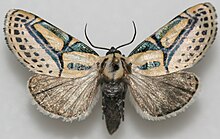Diprhera Festiva
| Diprhera Festiva | |
|---|---|

| |
| Научная классификация | |
| Домен: | Эукариота |
| Королевство: | Животное |
| Филум: | Членистоногие |
| Сорт: | Инсекта |
| Заказ: | Лепидоптера |
| Суперсемейство: | Ноктрический |
| Семья: | Nolidae |
| Род: | Дифтера |
| Разновидность: | D. Праздничный
|
| Binomial name | |
| Diphthera festiva (Fabricius, 1775)
| |
| Synonyms | |
| |

Diphthera Festiva , иероглифическая моль , является видом моли в семействе Nolidae и является единственной мотой в подсемейной дифтерине. [ 1 ] Он встречается в тропических и субтропических районах Южной Америки (до боливии и Бразилии ), Центральной Америки , Северной Америки и Карибского бассейна . В Северной Америке этот вид имеет юго -восточную дистрибуцию от Южной Каролины на запад до Техаса вдоль побережья Мексиканского залива . Безразличия были записаны на север, как Мичиган и Миссури . [ 2 ] Размах крыльев составляет 37–48 мм (1,5–1,9 дюйма). Этот вид иногда считается вредителем на соевых бобах. [ 3 ] Это было описано Йоханом Кристиан Фабрициусом в 1775 году.
Идентификация
[ редактировать ]Иероглифическая моль имеет светло-оранжевые мысли с отличительными сине-черными металлическими линиями и тремя рядами металлических точек, параллельных внешней краями. Заджуе черное с белой бахромой, а переднеспинка желтый оранжевый цвет с тремя черными полосами. Антенны живота, ноги и фирформные (нити) антенны черные. Мужчины и женщины одинаковы, за исключением одного заметного сексуального диморфизма : у женщин есть четыре голени на задних ногах, в то время как у мужчин есть только два.
The pupae are dark brown to black and around 1.7 cm long. They can be attached to trees or stems in rounded cocoons made of silk and small pieces of plant matter. The cocoons have a vertical exit slit characteristic of the family Nolidae.

The caterpillar has a red-orange head and anal plate and a white body with black rings. There are three or four incomplete black rings per segment that end before the cream-colored underside. The spiracles look like black dots and are located in between the black rings. On some caterpillars, there are also black stripes down the length of the body. The true legs and prolegs are black, and there is an orange spot above the prolegs on each side. The larvae feed in groups and their striking patterns may be aposematic, as reported by Becker and Miller (2002): "One male was tossed towards a gray kingbird, Tyrannus dominicensis (Gmelin), who caught it in the air, returned to its perch, tried to swallow the moth, then spit it out and cleaned its beak against the branch."[4]
Teran (1980) documented one parasitoid wasp of the family Chalcidae on a wild D. festiva caterpillar in Venezuela.[5]
The caterpillars feed mainly on Sterculiaceae, Fabaceae and Malvaceae species and can reach up to 4.5 cm in length.
Larval host plants
[edit]Host plant records include:
- Sterculiaceae:
- Melochia corchorifolia - chocolateweed
- Melochia pyrimidata - pyramid flower
- Melochia tomentosa - teabush
- Waltheria indica - sleepy morning
- Fabaceae:
- Lespedeza thunbergii - Thunberg's bushclover
- Glycine max - soybean
- Schrankia portoricensis
- Malvaceae:
Other species mentioned in the literature (description from Dunford and Barbara 2008): Phyllanthus latifolius (Euphorbiaceae), Boerhaavia diffusa (Nyctaginaceae), Morongia leptoclada (Mimosaceae), Carya sp. (Juglandaceae), Ipomoea batatas (Convolvulaceae), Cocos sp. (Arecaceae), Casuarina equisetifolia (Casuarinaceae), Corchorus hirsutus (Tiliaceae), and Lippia alba (Lamiaceae), and Solanum sp. (Solanaceae).[6]
Taxonomy
[edit]Formerly assigned to the family Noctuidae by Fibiger and Lafontaine (2005), recent phylogenetic and morphological analysis revealed that the hieroglyphic moth is more closely related to moths in the family Nolidae.[7] In addition to genetic similarity, D. festiva shares the main characteristic that unites Nolids: a rounded silk cocoon with plant matter woven in and a vertical exit slit. The hieroglyphic moth is now placed in its own subfamily, Diphtherinae, which is the sister group to the rest of the families within Nolidae.
References
[edit]- ^ Lafontaine, J. D. & Schmidt, B. C. (2013). "Additions and corrections to the check list of the Noctuoidea (Insecta, Lepidoptera) of North America north of Mexico". ZooKeys (264): 227–36. doi:10.3897/zookeys.264.4443. PMC 3668382. PMID 23730184.
- ^ Dunford, J. C.; Barbara, K. A. (January 1, 2008). "Diphthera festiva". University of Florida. Retrieved 2009-03-05.
- ^ Drees, B. M.; Rice, M. E. (1990). "Population dynamics and seasonal occurrence of soybean insect pests in southeastern Texas" (PDF). Southwestern Entomologist. Archived from the original (PDF) on 2016-03-04. Retrieved 2014-11-24.
- ^ Becker, V. O.; Miller, S. E. (2002). "The large moths of Guana Island, British Virgin Islands: a survey of efficient colonizers". Journal of the Lepidopterists' Society. 56.
- ^ Teran, J. (1980) Lista preliminar de hymenoptera parasitos de otros insectos en Venezuela. Revista de Ia Facultad de Agronomia Universidad Central de Venezuela.
- ^ Dyer, Lee A. (1997). "Effectiveness of caterpillar defenses against three species of invertebrate predators" (PDF). Journal of Research on the Lepidoptera. 34 (1–4): 48–68. doi:10.5962/p.266560. S2CID 17235603. Archived from the original (PDF) on 2018-01-28.
- ^ Захири, Р.; Laftaine, JD; Холлоуэй, JD; Китчинг, IJ; Шмидт, Британская Колумбия; Kaila, L. & Wahlberg, N. (2013). «Основные линии nolidae (lepidoptera, noctuoidea), выясненные молекулярной филогенетикой » Кладистика 29 (4): 337–3 Doi : 10.1111/ cla.1 PMID 34809410 56207549S2CID
Внешние ссылки
[ редактировать ]- Группа фотографов моты
- Бабочки и мотыльки Северной Америки - карта диапазона от гражданских данных
- Жирные системы - записи сбора и штрих -коды ДНК